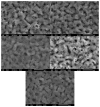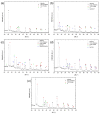Development of PEO in Low-Temperature Ternary Nitrate Molten Salt on Ti6Al4V
- PMID: 40805478
- PMCID: PMC12348440
- DOI: 10.3390/ma18153603
Development of PEO in Low-Temperature Ternary Nitrate Molten Salt on Ti6Al4V
Abstract
Titanium alloys are frequently subjected to surface treatments to enhance their biocompatibility and corrosion resistance in biological environments. Plasma electrolytic oxidation (PEO) is an environmentally friendly electrochemical technique capable of forming oxide layers characterized by high corrosion resistance, biocompatibility, and strong adhesion to the substrate. In this study, the PEO process was performed using a low-melting-point ternary eutectic electrolyte composed of Ca(NO3)2-NaNO3-KNO3 (41-17-42 wt.%) with the addition of ammonium dihydrogen phosphate (ADP). The use of this electrolyte system enables a reduction in the operating temperature from 280 to 160 °C. The effects of applied voltage from 200 to 400V, current frequency from 50 to 1000 Hz, and ADP concentrations of 0.1, 0.5, 1, 2, and 5 wt.% on the growth of titanium oxide composite coatings on a Ti-6Al-4V substrate were investigated. The incorporation of Ca and P was confirmed by phase and chemical composition analysis, while scanning electron microscopy (SEM) revealed a porous surface morphology typical of PEO coatings. Corrosion resistance in Hank's solution, evaluated via Tafel plot fitting of potentiodynamic polarization curves, demonstrated a substantial improvement in electrochemical performance of the PEO-treated samples. The corrosion current decreased from 552 to 219 nA/cm2, and the corrosion potential shifted from -102 to 793 mV vs. the Reference Hydrogen Electrode (RHE) compared to the uncoated alloy. These findings indicate optimal PEO processing parameters for producing composite oxide coatings on Ti-6Al-4V alloy surfaces with enhanced corrosion resistance and potential bioactivity, which are attributed to the incorporation of Ca and P into the coating structure.
Keywords: Ti alloy; biocompatibility; calcium phosphates; corrosion resistance; plasma electrolytic oxidation; ternary molten salt; titanium oxide.
Conflict of interest statement
The authors declare no conflicts of interest.
Figures









Similar articles
-
Surface Modification by Plasma Electrolytic Oxidation of Friction Surfacing 4043 Aluminum-Based Alloys Deposited onto Structural S235 Steel Substrate.Materials (Basel). 2025 Jul 13;18(14):3302. doi: 10.3390/ma18143302. Materials (Basel). 2025. PMID: 40731512 Free PMC article.
-
The Influence of Zn and Ca Addition on the Microstructure, Mechanical Properties, Cytocompatibility, and Electrochemical Behavior of WE43 Alloy Intended for Orthopedic Applications.Medicina (Kaunas). 2025 Jul 14;61(7):1271. doi: 10.3390/medicina61071271. Medicina (Kaunas). 2025. PMID: 40731900 Free PMC article.
-
Fabrication of Titanium Nitride Thin Film on Titanium Using Cathodic Arc Plasma Evaporation for Biomedical Application.Eur J Dent. 2025 Jul 23. doi: 10.1055/s-0045-1810016. Online ahead of print. Eur J Dent. 2025. PMID: 40701618
-
Management of urinary stones by experts in stone disease (ESD 2025).Arch Ital Urol Androl. 2025 Jun 30;97(2):14085. doi: 10.4081/aiua.2025.14085. Epub 2025 Jun 30. Arch Ital Urol Androl. 2025. PMID: 40583613 Review.
-
Chemical Passivation of Titanium and Ti-6Al-4V Alloy and Impact on Biocompatibility: A Comprehensive 50-Year Review and Best Practice Guidelines.J Biomed Mater Res B Appl Biomater. 2025 Aug;113(8):e35626. doi: 10.1002/jbm.b.35626. J Biomed Mater Res B Appl Biomater. 2025. PMID: 40714764 Review.
References
-
- Kim J., Shin D., Jang S., Kim T., Kim G.-H., Jung K., Kim H.G., Park J.H. Applicability of the Ti6Al4V Alloy to the Roller Arm for Aircraft Parts Made Using the DMLS Method. Int. J. Aeronaut. Space Sci. 2022;23:896–905. doi: 10.1007/s42405-022-00484-1. - DOI
-
- Inagaki I., Takechi T., Ariyasu Y.S.N. Application and Features of Titanium for the Aerospace Industry. Nippon. Steel Sumitomo Met. Tech. Rep. 2014;106:22–27.
-
- Srivastava M., Jayakumar V., Udayan Y., M S., S M M., Gautam P., Nag A. Additive Manufacturing of Titanium Alloy for Aerospace Applications: Insights into the Process, Microstructure, and Mechanical Properties. Appl. Mater. Today. 2024;41:102481. doi: 10.1016/j.apmt.2024.102481. - DOI
-
- Singh P., Pungotra H., Kalsi N.S. On the Characteristics of Titanium Alloys for the Aircraft Applications. Mater. Today Proc. 2017;4:8971–8982. doi: 10.1016/j.matpr.2017.07.249. - DOI
-
- Wang Y., Lu Y., Wang Y., Wu Y., Gao Q., Zhang C. Investigation on Thermal Performance of Quinary Nitrate/Nitrite Mixed Molten Salts with Low Melting Point for Thermal Energy Storage. Sol. Energy Mater. Sol. Cells. 2024;270:112803. doi: 10.1016/j.solmat.2024.112803. - DOI
LinkOut - more resources
Full Text Sources

